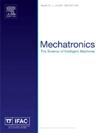Practical and robust incremental model predictive control for flexible-joint robots
IF 3.1
3区 计算机科学
Q2 AUTOMATION & CONTROL SYSTEMS
引用次数: 0
Abstract
This article proposes an optimization-based method for robust yet efficient control of flexible-joint robots by using the model predictive control approach. The time-delay estimation (TDE) technique is used to approximate uncertain and nonlinear dynamic equations, where neither concrete knowledge of mathematical system model parameters is required in the approximation, thus granting the model-free property for dynamics compensation and real-time system linearization. TDE is integrated with model predictive control, which is designated as the incremental model predictive control (IMPC) framework. This approach guarantees the tracking performance of the flexible joint robot with input and output constraints, such as motor torque and joint states. Moreover, the proposed controller can practically circumvent high-order derivatives in implementation while providing robust tracking, a capability that conventional methods for flexible joint robots often face challenges due to the inherent nature of their high-order dynamics. The input-to-state stability of IMPC in a local region around the reachable reference trajectory is theoretically proven, and the high approximation accuracy of the resulting incremental system is analyzed. Finally, a series of experiments is conducted on a flexible-joint robot to verify the practical effectiveness of IMPC, and superior performance in terms of high accuracy, high computational efficiency, and constraint admissibility is demonstrated.
柔性关节机器人实用鲁棒增量模型预测控制
本文提出了一种基于优化的柔性关节机器人鲁棒高效控制方法——模型预测控制方法。时延估计(TDE)技术用于逼近不确定和非线性动力学方程,在逼近时不需要具体的系统数学模型参数知识,从而使动态补偿和实时系统线性化具有无模型性。将TDE与模型预测控制相结合,称为增量模型预测控制(IMPC)框架。该方法在电机转矩和关节状态等输入输出约束条件下保证了柔性关节机器人的跟踪性能。此外,所提出的控制器实际上可以在实现中绕过高阶导数,同时提供鲁棒跟踪,这是柔性关节机器人的传统方法由于其高阶动力学的固有性质而经常面临挑战的能力。从理论上证明了IMPC在可达参考轨迹附近局部区域的输入-状态稳定性,并分析了由此产生的增量系统的高逼近精度。最后,在一个柔性关节机器人上进行了一系列实验,验证了IMPC的实际有效性,并在高精度、高计算效率和约束容忍度方面表现出优异的性能。
本文章由计算机程序翻译,如有差异,请以英文原文为准。
求助全文
约1分钟内获得全文
求助全文
来源期刊

Mechatronics
工程技术-工程:电子与电气
CiteScore
5.90
自引率
9.10%
发文量
0
审稿时长
109 days
期刊介绍:
Mechatronics is the synergistic combination of precision mechanical engineering, electronic control and systems thinking in the design of products and manufacturing processes. It relates to the design of systems, devices and products aimed at achieving an optimal balance between basic mechanical structure and its overall control. The purpose of this journal is to provide rapid publication of topical papers featuring practical developments in mechatronics. It will cover a wide range of application areas including consumer product design, instrumentation, manufacturing methods, computer integration and process and device control, and will attract a readership from across the industrial and academic research spectrum. Particular importance will be attached to aspects of innovation in mechatronics design philosophy which illustrate the benefits obtainable by an a priori integration of functionality with embedded microprocessor control. A major item will be the design of machines, devices and systems possessing a degree of computer based intelligence. The journal seeks to publish research progress in this field with an emphasis on the applied rather than the theoretical. It will also serve the dual role of bringing greater recognition to this important area of engineering.
 求助内容:
求助内容: 应助结果提醒方式:
应助结果提醒方式:


